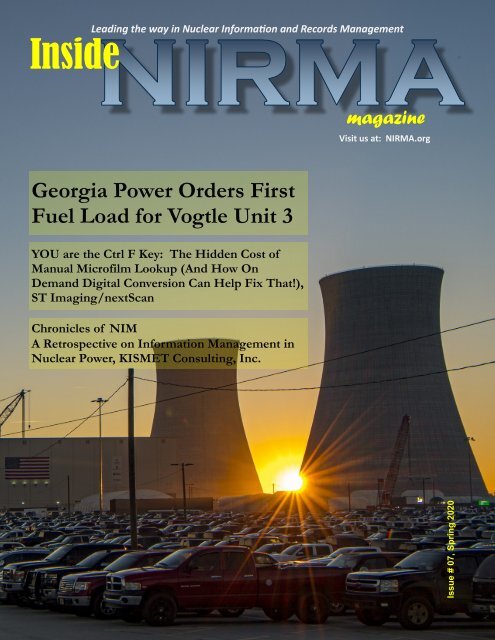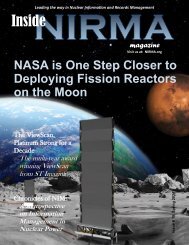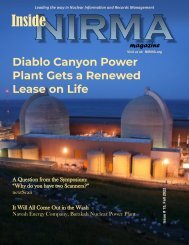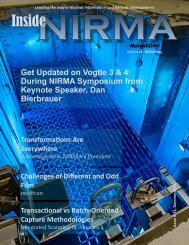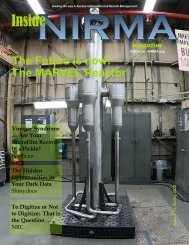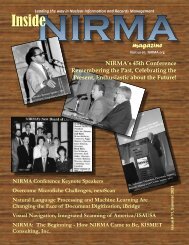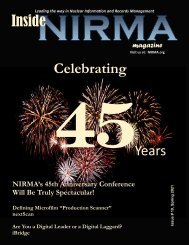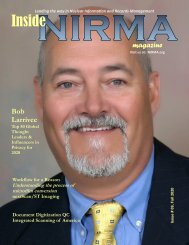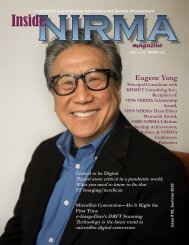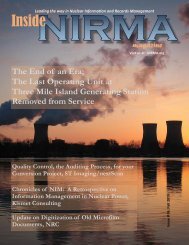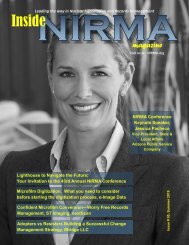Inside NIRMA Spring 2020 FINAL
You also want an ePaper? Increase the reach of your titles
YUMPU automatically turns print PDFs into web optimized ePapers that Google loves.
Issue # 07, <strong>Spring</strong> <strong>2020</strong><br />
<strong>Inside</strong><br />
Leading the way in Nuclear Information and Records Management<br />
magazine<br />
Visit us at: <strong>NIRMA</strong>.org<br />
Georgia Power Orders First<br />
Fuel Load for Vogtle Unit 3<br />
YOU are the Ctrl F Key: The Hidden Cost of<br />
Manual Microfilm Lookup (And How On<br />
Demand Digital Conversion Can Help Fix That!),<br />
ST Imaging/nextScan<br />
Chronicles of NIM<br />
A Retrospective on Information Management in<br />
Nuclear Power, KISMET Consulting, Inc.
Contents<br />
<strong>Spring</strong> <strong>2020</strong><br />
4<br />
7<br />
10<br />
Georgia Power Orders First Fuel Load for Vogtle Unit 3<br />
YOU are the Ctrl F Key: The Hidden Cost of Manual<br />
Microfilm Lookup (And How On Demand Digital<br />
Conversion Can Help Fix That!)<br />
By Arijana Dizdarevic, Sales & Marketing Coordinator, STimaging / nextScan<br />
Chronicles of NIM: A Retrospective on Information<br />
Management in Nuclear Power<br />
By Eugene Yang, Kismet Consulting<br />
12<br />
14<br />
<strong>2020</strong> <strong>NIRMA</strong> Conference Keynote Speakers<br />
<strong>NIRMA</strong> Transforming the <strong>2020</strong> Conference<br />
By Janice Hoerber, Vice President of <strong>NIRMA</strong><br />
Front and Back Cover Photos: Georgia Power Company Plant:<br />
Front Cover (left) Plants Vogtle Units 1-4.<br />
Back Cover (right) Vogtle Unit 3 Reactor Vessel Cavity.<br />
2 <strong>Spring</strong> <strong>2020</strong> <strong>NIRMA</strong>.org <strong>Inside</strong> <strong>NIRMA</strong>
CONTENTS<br />
in every issue<br />
FROM YOUR PRESIDENT—9<br />
SECRETARY NEWS—15<br />
TREASURER REPORT—16<br />
PDBU NEWS—16<br />
M&MBU NEWS—17<br />
NOMINATING COMMITTEE—17<br />
INDUSTRY NEWS—18<br />
Editors<br />
Neal and Sandra Miller<br />
DevereauxInc@outlook.com<br />
A Note from the Editors<br />
Help us Grow our<br />
Social Media Presence!<br />
In 2019, <strong>NIRMA</strong> took steps to further establish itself on<br />
social media, this included adding a Twitter account and<br />
taking the opportunity to communicate more frequently via<br />
Facebook and LinkedIn. With Facebook and Twitter alone,<br />
we were able to add nearly 400 followers and reach more<br />
than 25,000 people.<br />
While we were happy with those results, we aren’t<br />
through and to quote an old Carpenters song “We’ve Only<br />
Just Begun.” The <strong>NIRMA</strong> Board of Directors established<br />
“Increase <strong>NIRMA</strong>’s awareness by continued use of the<br />
<strong>NIRMA</strong> website and social media” as one of its key goals<br />
for <strong>2020</strong>. In pursuing this goal, we believe it will help us<br />
grow our membership and increase vendor participation.<br />
And by continuing to get bigger and better, it will allow us<br />
to increase the value we are able to provide our<br />
membership.<br />
Now the big question. How can you help? If you<br />
haven’t already, take a moment to like and follow us on<br />
Facebook and follow us on Twitter, LinkedIn and our newly<br />
established Instagram account. To take things to the next<br />
level, when you see a post from us, comment on it and<br />
share it with others.<br />
To help get you started, the links to each of our social<br />
media platforms are within the icons below. Please take a<br />
moment to follow us on Twitter and Instagram, like us on<br />
Facebook, and connect with us on LinkedIn.<br />
Thank you for your support!<br />
Neal & Sandra Miller<br />
Advertising<br />
Neal.F.Miller@gmail.com<br />
<strong>NIRMA</strong> Headquarters<br />
Sarah Perkins<br />
<strong>NIRMA</strong> Administrator<br />
245 Sunnyridge Ave., #41<br />
Fairfield, CT 06824<br />
nirma@nirma.org<br />
<strong>Inside</strong> <strong>NIRMA</strong> <strong>NIRMA</strong>.org <strong>Spring</strong> <strong>2020</strong> 3
Georgia Power Orders First Fuel<br />
Load for Vogtle Unit 3<br />
G<br />
eorgia Power has ordered<br />
the first nuclear fuel load<br />
for Vogtle Unit 3, the first<br />
nuclear fuel order to be<br />
placed in more than 30 years for a<br />
newly-designed reactor in the U.S.<br />
The fuel order marks another<br />
significant milestone at the Vogtle<br />
nuclear expansion near Waynesboro,<br />
Georgia.<br />
Consisting of 157 fuel assemblies<br />
with each measuring 14 feet tall, the<br />
fuel will eventually be loaded into<br />
the Unit 3 reactor vessel to support<br />
startup once the reactor begins<br />
operating. After this initial fueling,<br />
approximately one third of the total<br />
fuel assemblies will be replaced<br />
during each refueling outage after<br />
the units begin operating, similar to<br />
the process used at existing Vogtle<br />
units 1 and 2.<br />
The fuel order for Vogtle Unit 3<br />
comes just months after the<br />
placement of the containment vessel<br />
top, which was witnessed by U.S.<br />
Energy Secretary Rick Perry,<br />
Georgia Governor Brian Kemp,<br />
Plant Vogtle Unit 4 (Image: Georgia Power Company)<br />
U.S. Agriculture Secretary Sonny<br />
Perdue, North America's Building<br />
Trades Unions President Sean<br />
McGarvey, members of Congress<br />
and all five members of the Georgia<br />
Public Service Commission,<br />
signifying that all modules and large<br />
components have been placed inside<br />
the unit.<br />
In addition, the placement of<br />
three low-pressure turbine rotors<br />
and the generator rotor inside the<br />
Unit 3 turbine building have also<br />
been completed. The turbine rotors,<br />
weighing approximately 200 tons<br />
each and rotating at 1,800<br />
revolutions per minute, will pass<br />
steam through the turbine blades to<br />
power the generator and supply<br />
electricity to the grid. The highpressure<br />
turbine rotor will be<br />
installed in the coming weeks.<br />
Plant Vogtle Unit 3 Containment Vessel (Image: Georgia Power Company)<br />
4 <strong>Spring</strong> <strong>2020</strong> <strong>NIRMA</strong>.org <strong>Inside</strong> <strong>NIRMA</strong>
Plant Vogtle Unit 3 and 4 (Image: Georgia Power Company)<br />
The generator rotor is the moving<br />
component of the electromagnetic<br />
system of the electric generator. As<br />
the turbines rotate, they turn the<br />
generator rotor. The generator rotor<br />
is surrounded by the generator stator<br />
that work together creating an<br />
electromagnetic field to generate<br />
electricity.<br />
Significant progress continues to<br />
be made at the construction site as<br />
the project workforce remains at an<br />
all-time high with approximately<br />
8,000 workers on site. With more<br />
than 800 permanent jobs available<br />
once the units begin operating,<br />
Vogtle 3 & 4 is currently the largest<br />
jobs-producing construction<br />
project in the state of Georgia.<br />
Looking inside the Plant Vogtle Unit 4 cooling tower (Image: Georgia Power Company)<br />
<strong>Inside</strong> <strong>NIRMA</strong> <strong>NIRMA</strong>.org <strong>Spring</strong> <strong>2020</strong> 5
By Arijana Dizdarevic<br />
Sales & Marketing Coordinator, STimaging / nextScan<br />
H<br />
ow much time does it take<br />
to look up just one record<br />
from a roll of microfilm?<br />
All you need to do is<br />
retrieve ONE piece of information<br />
from it. Simple! How long could that<br />
take?<br />
In our day-to-day digital world,<br />
we have grown accustom to instantly<br />
receiving information, but anyone<br />
who’s worked with microfilm knows<br />
that getting information from that<br />
medium could result in a lengthy<br />
task. You just fell into the classic<br />
“trap” of manual retrieval – one of<br />
the biggest hidden time sinks of<br />
record requests from analog film.<br />
The trouble with pulling records<br />
from microfilm is that you are not<br />
done once you find the microfilm<br />
roll. You have only just begun. Any<br />
roll of microfilm might contain up to<br />
1,500 documents, and it’s up to you<br />
to find the requested record.<br />
How long will that take?<br />
• If you can identify a<br />
document from a quick glance<br />
at the title, one second per<br />
frame would mean it takes 25<br />
minutes to get all the way<br />
through a roll of 1,500<br />
documents.<br />
• If you have to take a more indepth<br />
look, say 10 seconds,<br />
then that could equal more<br />
than four hours per roll!<br />
• Sometimes you’ll be lucky and<br />
the document you want will<br />
be right at the start, but<br />
sometimes it’ll be at the end.<br />
Taking the average, you are<br />
looking through 750<br />
documents.<br />
• That means that a typical<br />
“quick” records search of a<br />
full roll should take about 12<br />
minutes, while an in-depth<br />
search can take hours.<br />
The reason, and of course you know,<br />
because you have to read what is on<br />
each frame of film. On a modern PC<br />
running an MS Word or PDF file,<br />
simply entering Ctrl-F allows for a<br />
search function and jumping<br />
through a few highlighted keywords.<br />
With a manual process like<br />
microfilm, you are the Ctrl-F key,<br />
because your machine can’t do it for<br />
you.<br />
Continued on next page.<br />
<strong>Inside</strong> <strong>NIRMA</strong> <strong>NIRMA</strong>.org <strong>Spring</strong> <strong>2020</strong> 7
STimaging<br />
next can<br />
S<br />
Of course, certain things can help you cut down<br />
the manual search time, such as a table of contents, or<br />
if you have a general idea of where in the film to look.<br />
But luck or experience is a requirement there, and on<br />
average, you’re still probably going to spend at least 5<br />
or 10 minutes on a records lookup, even if you’re<br />
good and lucky.<br />
It is time to stop<br />
manually retrieving<br />
microfilm records. Step<br />
into the digital age by<br />
converting those<br />
records to digital<br />
microfilm ribbons and<br />
find the documents<br />
practically instantly.<br />
Let the computer do<br />
what it is good at and<br />
be the Ctrl-F command.<br />
Why Digitizing Your Microfilm<br />
Collection Saves Time – And Pays<br />
for Itself in the Long Run<br />
It may look like we spent the past several<br />
paragraphs discussing how inefficient it is to manually<br />
look up records on microfilm, but what we really want<br />
to show you is how much time it saves to do the<br />
process digitally.<br />
You can conduct a search on microfilm rolls just<br />
like you can with a PDF – you just need to convert the<br />
microfilm into a digital microfilm ribbon first. Then run<br />
a simple optical character recognition program to make<br />
it searchable. Besides the obvious practical benefits, like<br />
preservation, backing up the records, and protecting<br />
your collection from “Vinegar Syndrome” rot, you’ll be<br />
able to save a lot of time by getting an assist from your<br />
computer on every search you do.<br />
Digitizing an entire roll of microfilm to a digital file<br />
format can take as little as one minute on today’s fastest<br />
high-speed conversion unit. While scanning at a high<br />
rate is beneficial to your conversion project,<br />
guaranteeing that every file was digitized is critical to<br />
record retention requirements. Combined with software<br />
designed for batch audit processing, the daunting task of<br />
combing through thousands of files is simplified with a<br />
ribbon auditor. Users can see an entire scan and quickly<br />
check for complete capture, in addition to applying<br />
universal image enhancements to the ribbon or a<br />
selected group of frames. The key to completing your<br />
conversion project in one piece and on time is not only<br />
fast scanning but also fast auditing capabilities.<br />
High-speed microfilm conversion scanners will<br />
steer your department towards maximum operational<br />
efficiency by streamlining the record retrieval process.<br />
By instituting an on-demand process your staff can<br />
capture and convert entire rolls of microfilm as records<br />
are requested without making drastic changes to your<br />
existing business process. Any time there is a records<br />
request, simply capture the whole roll instead, find what<br />
you’re looking for using a fast search, and keep the<br />
digital copy forever – all in about the same amount of<br />
time it would have taken you to find the information<br />
manually.<br />
It is time to stop manually retrieving microfilm<br />
records. Step into the digital age by converting those<br />
records to digital microfilm ribbons and find the<br />
documents practically instantly. Let the computer do<br />
what it is good at and be the Ctrl-F command.<br />
STimaging<br />
S<br />
next can<br />
Click here to<br />
Contact us!<br />
8 <strong>Spring</strong> <strong>2020</strong> <strong>NIRMA</strong>.org <strong>Inside</strong> <strong>NIRMA</strong>
From the President<br />
Michelle M. Smith<br />
T<br />
his past month the <strong>NIRMA</strong> Board of<br />
Directors met for our Winter Board meeting.<br />
The Board collectively reviewed our Strategic<br />
Plan and goals. We took an in-depth look at<br />
how we will achieve our goals for <strong>2020</strong>. The <strong>NIRMA</strong><br />
Strategic Plan states <strong>NIRMA</strong> is the industry leader in<br />
information and records management, uniquely<br />
qualified to provide:<br />
• guidance to our members in the areas of<br />
quality records programs,<br />
• regulatory compliance activities,<br />
• electronic records initiatives,<br />
• document management technologies, and<br />
• knowledge management issues.<br />
To comply with our Strategic Plan and goals<br />
<strong>NIRMA</strong> continues to seek visionaries to share ideas<br />
and to create a platform for our audience to discuss<br />
how to address the industry’s biggest challenges and<br />
create opportunities through using innovative tools.<br />
<strong>NIRMA</strong> has been working with industry peers to<br />
identify speakers for the upcoming conference. We<br />
have an array of presenters with topics that will be<br />
prevalent to our industry.<br />
Just a few of the top speakers already<br />
confirmed for <strong>2020</strong> include:<br />
• David Nelson, NRC Chief Information<br />
Officer and Chief Data Officer, will provide<br />
an overview of the NRC initiatives that will<br />
drive changes for our industry on August 2.<br />
• Colleen R. McClanahan, Directorate,<br />
Management & Program Analyst, FAC-COR<br />
with the Federal Bureau of Investigation on<br />
August 2.<br />
• Laura Williams, with the American Nuclear<br />
Insurers (ANI) has an extensive background<br />
in Health Physics and Decommissioning, will<br />
be the Keynote Speaker on August 3.<br />
• Karen Fili, current President & CEO of<br />
URENCO USA. Previously Site VP at<br />
Southern Company for Vogtle 3 & 4, and Site<br />
VP at Monticello Nuclear plant, will be the<br />
Keynote Speaker on August 4.<br />
For additional information on two Keynote<br />
Speakers, see pages 12 and 13.<br />
If you would like to present a topic or get involved<br />
in <strong>NIRMA</strong>, please contact us at nirma@nirma.org.<br />
Not a Member of <strong>NIRMA</strong>?<br />
Click here to join today!<br />
<strong>Inside</strong> <strong>NIRMA</strong> <strong>NIRMA</strong>.org <strong>Spring</strong> <strong>2020</strong> 9
I<br />
A Retrospective on Information<br />
Management in Nuclear Power<br />
By Eugene Y. Yang, KISMET Consulting, Inc.<br />
t was not necessarily always<br />
about document control and<br />
records management. I did<br />
process improvement consulting from<br />
the 1990’s and into 2000’s when<br />
“globalization” really emerged and<br />
competition was for real. This<br />
resulted in the “right-sizing” of<br />
companies; deregulation came to the<br />
electric utility sector, forcing the<br />
nuclear power industry to look at<br />
better efficiencies. This issue’s article<br />
reflects my experience in process<br />
improvement versus technology<br />
change.<br />
Growing up, I was a big fan of<br />
science fiction. I loved anthologies;<br />
you could<br />
read a<br />
variety of<br />
great short<br />
stories, filled<br />
with science<br />
“gee whiz”.<br />
One story<br />
that stuck<br />
with me was<br />
“The<br />
Specter<br />
General” by<br />
Theodore<br />
Cogswell. A maintenance battalion<br />
of the Imperial Space Marines<br />
establishes a<br />
base on an<br />
uninhabited<br />
planet, but it’s<br />
forgotten as the<br />
empire falls<br />
into civil war. For the next 500<br />
years, the soldiers doggedly stick to<br />
their mission in training for starships<br />
that never come. They lapse into a<br />
primitive farming and hunting<br />
existence, exhibiting characteristics<br />
of the American Indian culture.<br />
“Braves” are garbed in buckskin,<br />
wearing feathers that identify their<br />
company or platoon, and on their<br />
arms are painted rank insignia. One<br />
day, starships do show up, but they<br />
are sorely in need of maintenance.<br />
One particular brave immediately<br />
identifies one of the problems and<br />
fixes it. Astonished, the starship<br />
captain asks how did the brave know<br />
how to repair the problem, the brave<br />
shrugged and said, “That’s how I’ve<br />
always done it.”<br />
Starting in the late 1970s and into<br />
the 1990’s, the resurgent Japanese<br />
industrial base produced<br />
competitively priced, high-quality<br />
goods, staggering the economies of<br />
North America and Western Europe.<br />
For example, the United Kingdom,<br />
for the first time since the Industrial<br />
Revolution, became a net importer<br />
of finished goods. The big secret?<br />
The Japanese studied, implemented,<br />
and refined the quality management<br />
principles espoused by W. Edward<br />
Demig: Plan-Do-Study-Act (PDSA).<br />
“Process Improvement”, “Process<br />
Re-engineering”, and other like<br />
terms became all the rage.<br />
A good portion of the consulting<br />
that I did in those days was directed<br />
at achieving greater production in<br />
the capture, review, indexing,<br />
storage, and disposition of<br />
documents and records piling up at<br />
near mythic volumes. This work<br />
addressed not only fundamental<br />
recordkeeping processes, but also<br />
major plant processes, such as design<br />
change/modification, supply chain,<br />
maintenance management, and<br />
configuration management. I got to<br />
use cool (well, at the time!) tools<br />
such as MetaVision or IEW’s<br />
Knowledgeware that helped in<br />
modeling processes.<br />
The debate back then (and<br />
continues today!) is: which “answer”<br />
takes the lead - is it an improved<br />
process or is it better technology? I<br />
am still amused at the “armed<br />
10 <strong>Spring</strong> <strong>2020</strong> <strong>NIRMA</strong>.org <strong>Inside</strong> <strong>NIRMA</strong>
camps” – the “process” or business people were all<br />
about the latest and greatest computer technology that<br />
would take care of their problems, and the information<br />
technologists would be about getting the “fill-in-theblank<br />
users” to come up with a cogent process<br />
description so they could fit in the technology.<br />
When I would facilitate a process review, there would<br />
be times when I’d scratch my head on a particular series<br />
of steps, and ask “why do you do this?” I’d get back,<br />
“That’s how we’ve always done it.” I would then think,<br />
you know, that’s a bad process; if they implement the<br />
system according to this process, they’re only making a<br />
bad process go faster! On the other hand, the nature-of<br />
-the-beast with technology is that there is an inherent<br />
“management system” in the software, processes that<br />
may not fit a company’s current culture or processes.<br />
So, do you adopt the process to meet the system, or do<br />
you adopt the system to meet the process?<br />
I’ve seen it both ways, with extraordinary hoopjumping<br />
and accompanying cultural angst. On one<br />
hand, so much change was done to a software<br />
application to meet a company’s process that it was<br />
Back then, the buzzword<br />
that got change going<br />
was “total quality<br />
management”; today,<br />
it’s Lean-Six Sigma.<br />
Tomorrow? No doubt<br />
there will be another<br />
methodology to get<br />
excited about, but the<br />
clash will be the same: is<br />
it process improvement<br />
or technology change?<br />
nearly unrecognizable if you saw that system used in<br />
another company. On the other hand, I’ve seen “edicts<br />
from on high” that the software must be used “as-is”,<br />
so the company needs to change its ways of doing<br />
business to meet it. Don’t get me wrong; there are valid<br />
reasons for either way, with justified cost-benefits, it’s<br />
just an interesting dichotomy I’ve observed – or been a<br />
part of!<br />
The best implementations, especially at the fleet-wide<br />
scale, is where a compromise is achieved between<br />
process improvement and technology change. There are<br />
some processes that must stay in place in order to meet<br />
regulatory needs (“if the process is bad, go tell the<br />
guv’mint!”); on the other hand, if a software company<br />
has a track record of effective success, a client should<br />
“listen” as to why the automated process is in place and<br />
strive to implement it.<br />
Back then, the buzzword that got change going was<br />
“total quality management”; today, it’s Lean-Six Sigma.<br />
Tomorrow? No doubt there will be another<br />
methodology to get excited about, but the clash will be<br />
the same: is it process improvement or technology<br />
change?<br />
Eugene has been a member of <strong>NIRMA</strong> for<br />
over 33 years. At the time he joined,<br />
<strong>NIRMA</strong> had only been in existence for 11<br />
years. He would love to hear about stories<br />
and anecdotes from others, so please email<br />
him at:<br />
eugene.yang@kismetconsulting.com.<br />
<strong>Inside</strong> <strong>NIRMA</strong> <strong>NIRMA</strong>.org <strong>Spring</strong> <strong>2020</strong> 11
<strong>NIRMA</strong> <strong>2020</strong> Conference<br />
Keynote<br />
speaker<br />
David Nelson currently serves as<br />
the Chief Information Officer (CIO)<br />
and Chief Data Officer (CDO) of<br />
the Nuclear Regulatory Commission<br />
(NRC). Mr. Nelson was selected for<br />
this role in 2016 to oversee the<br />
NRC’s information technology/<br />
information management (IT/IM)<br />
portfolio, including those IT systems<br />
supporting nuclear reactor safety and<br />
nuclear materials and waste safety.<br />
In addition to the IT/IM<br />
portfolio, Mr. Nelson is responsible<br />
for the NRC’s information resource<br />
management, enterprise architecture<br />
program, cybersecurity program,<br />
information and records<br />
management program, information<br />
collection program, and the agency’s<br />
implementation of the Freedom of<br />
Information Act and the Federal<br />
Privacy Act of 1974.<br />
Mr. Nelson previously held<br />
several executive roles at the Centers<br />
for Medicare and Medicaid Services<br />
(CMS), including CIO and Director,<br />
Office of Enterprise Information;<br />
Director, Office of Information<br />
Services; Director, Office of<br />
Enterprise Management; and<br />
Director, Data Analytics and Control<br />
Group for the Center for Program<br />
Integrity. Mr. Nelson’s Office<br />
managed the CMS’s $2.6 billion IT<br />
portfolio, including the complex<br />
ecosystem of applications and<br />
trusted data exchanges supporting<br />
Healthcare.gov, the Medicare claims<br />
processing system, and the Medicaid<br />
support and quality reporting<br />
systems. Mr. Nelson joined CMS in<br />
2004 as the Director, Division of<br />
Call Center Systems, Office of<br />
External Affairs and Beneficiary<br />
Services, and was charged with<br />
improving access to information for<br />
40 million Medicare beneficiaries.<br />
Before joining CMS, Mr. Nelson<br />
served in a variety of challenging<br />
private sector leadership roles,<br />
including co-founder of two<br />
broadband development companies<br />
that provided access to underserved<br />
markets in the United States.<br />
Mr. Nelson also served in<br />
executive operations roles both in<br />
the United States and abroad for<br />
several leading IT development and<br />
telecommunications companies, and<br />
as Vice President of Operations for a<br />
telecommunications firm where he<br />
managed the commissioning of<br />
several hundred satellite earth<br />
stations in 50 countries across<br />
Europe, Latin America, and the<br />
United States.<br />
Save the<br />
date!<br />
The 44 th Annual Nuclear<br />
Information Management<br />
Conference will be held on<br />
August 2-4, <strong>2020</strong>.<br />
12 <strong>Spring</strong> <strong>2020</strong> <strong>NIRMA</strong>.org <strong>Inside</strong> <strong>NIRMA</strong>
<strong>NIRMA</strong> <strong>2020</strong> Conference<br />
Keynote<br />
speaker<br />
Colleen McClanahan is a<br />
Management & Program Analyst<br />
with the Federal Bureau of<br />
Investigation (FBI). Ms.<br />
McClanahan began her FBI career in<br />
2011 where she managed multiple<br />
information technology contracts in<br />
the FBI’s Information Technology<br />
Branch. Ms. McClanahan<br />
transferred to the Weapons of Mass<br />
Destruction Directorate (WMDD) is<br />
2013 where she managed the<br />
Directorate’s Contract<br />
Administration Program and<br />
implemented executive management<br />
strategic objectives regarding<br />
personnel assets. In 2014, she<br />
transferred to her current position,<br />
within WMDD, to the Nuclear and<br />
Radiological Countermeasures Unit<br />
(NRCU). Ms. McClanahan has<br />
provided program management on<br />
several international and domestic<br />
nuclear and radiological programs<br />
where she provides subject matter<br />
expertise on implementing<br />
countermeasures and tripwires to<br />
prevent, detect and respond to<br />
radiological and nuclear terrorism<br />
incidents.<br />
In addition to her day-to-day<br />
responsibilities in NRCU, Ms.<br />
McClanahan is a member of the<br />
FBI’s Victim Services Response<br />
Team where she supports the FBI’s<br />
response to mass casualty incidents.<br />
Ms. McClanahan received her<br />
Bachelor’s Degree in<br />
Communication Studies from<br />
Towson University. Prior to joining<br />
the FBI, Ms. McClanahan was the<br />
Director of Administration and<br />
Meetings Manager for Bostrom<br />
Corporation, an association<br />
management company.<br />
Ms. McClanahan will present<br />
“How the Federal Bureau of<br />
Investigation (FBI) Counters the<br />
Radiological Threat”.<br />
Description: The mission of the<br />
FBI is to protect the American<br />
people and uphold the Constitution<br />
of the United States. The FBI<br />
created the Weapons of Mass<br />
Destruction Directorate (WMDD)<br />
to build a cohesive and coordinated<br />
approach to incidents involving<br />
chemical, biological, radiological,<br />
nuclear, or explosive (CBRNe)<br />
material—with an overriding focus<br />
on prevention. Through a nuclear<br />
and radiological tripwire initiative,<br />
the FBI provides awareness briefing<br />
that discuss potential threats and<br />
vulnerabilities regarding the use of,<br />
research of, or manufacturing of<br />
radiological sources. The purpose of<br />
this presentation is to discuss:<br />
• An overview of the FBI,<br />
• the role of the WMD<br />
Coordinator,<br />
• types of threats applicable to<br />
<strong>NIRMA</strong> members,<br />
• suspicious behaviors, and<br />
• real world case studies.<br />
<strong>Inside</strong> <strong>NIRMA</strong> <strong>NIRMA</strong>.org <strong>Spring</strong> <strong>2020</strong> 13
<strong>NIRMA</strong> Transforming the<br />
<strong>2020</strong> Conference<br />
Janice Hoerber, Vice President<br />
I<br />
<strong>2020</strong>).<br />
t is an exciting time as we<br />
plan for the 44 th Nuclear<br />
Information Management<br />
Conference (August 2-4,<br />
<strong>NIRMA</strong> is embracing change and<br />
unveiling a new look for the <strong>2020</strong><br />
conference in the exclusive Palms<br />
Executive Conference Center at the JW<br />
Marriott Las Vegas Resort and Spa.<br />
For over a decade, the conference<br />
has been located in the Marquis<br />
Conference area. The <strong>NIRMA</strong><br />
Board is delighted with the new<br />
conference space in the Palms<br />
Tower and believe it will be a<br />
welcomed change for attendees and<br />
vendor exhibitors.<br />
The <strong>2020</strong> <strong>NIRMA</strong> Conference<br />
schedule will be changed up to<br />
revitalize the tracks and session<br />
topics to meet the needs of a<br />
broader audience. Each day will<br />
include a special Keynote speaker to<br />
share industry perspectives. An<br />
emphasis will also be on a<br />
Fundamentals track Sunday for the<br />
beginner as well as those looking for<br />
a refresher. Your feedback from last<br />
year's conference has been helpful in<br />
making adjustments for this August!<br />
We look forward to a terrific<br />
lineup of speakers and topics in<br />
August! The Call for Papers is<br />
posted on the <strong>NIRMA</strong> website (click<br />
here) with a variety of relevant topics<br />
to consider. Submit your 100-150<br />
word abstract of your presentation<br />
in March to Janice Hoerber,<br />
<strong>NIRMA</strong> Vice President at<br />
jhoerber@ameren.com.<br />
This year's<br />
<strong>NIRMA</strong><br />
conference<br />
theme is focused<br />
on the Nuclear<br />
Transformation<br />
and Embracing<br />
Change in your<br />
workplace.<br />
The <strong>NIRMA</strong> conference offers a<br />
forum for excellent networking.<br />
The conference schedule will be<br />
packed with learning opportunities<br />
as well as knowledge sharing among<br />
peers and the regulators.<br />
Highlight of the <strong>2020</strong><br />
Conference events:<br />
• Educational Opportunities<br />
for signup (coming soon)<br />
Saturday, August 1<br />
• Opening Day Keynote, plus<br />
ICRM Prep &<br />
Fundamentals track Sunday,<br />
August 2<br />
• Welcome Reception (food &<br />
beverages) early evening,<br />
Sunday, August 2<br />
• Vendor Exhibits & Raffles<br />
Monday, August 3 with<br />
dedicated Solution Spotlight<br />
talks<br />
• Keynotes, Technical<br />
Sessions and Panel<br />
Discussions Monday &<br />
Tuesday, August 3-4<br />
• <strong>NIRMA</strong> Business Unit<br />
meetings Wednesday, August<br />
5 & tentatively Thursday,<br />
August 6<br />
The Vendor Exhibitor<br />
Extravaganza will have a great new<br />
look Monday, August 3 in the<br />
Cascades ballroom!<br />
Continue checking the <strong>NIRMA</strong><br />
website at www.nirma.org for all the<br />
details and to register for the<br />
conference. We look forward to<br />
seeing you there!<br />
14 <strong>Spring</strong> <strong>2020</strong> <strong>NIRMA</strong>.org <strong>Inside</strong> <strong>NIRMA</strong>
Sheila Pearcy, CRA<br />
W<br />
ell it has been a good year<br />
and here we are off to a<br />
good start for <strong>2020</strong>. The<br />
<strong>NIRMA</strong> Board of Directors<br />
(BOD) met in Summerlin for the Biannual<br />
Board Meetings in February.<br />
Much was accomplished. The Board<br />
discussed, reviewed and established:<br />
• <strong>NIRMA</strong> <strong>2020</strong> BOD Goals<br />
• Status of <strong>NIRMA</strong> Organization<br />
• Treasurer’s Report and <strong>2020</strong><br />
Budget<br />
• 5-Year Strategic Plan<br />
• SWOT (Strengths, Weaknesses,<br />
Opportunities, Threats)<br />
SUMMARY of <strong>NIRMA</strong> 2019<br />
ACCOMPLISHMENTS:<br />
• Successful 43rd Annual <strong>NIRMA</strong><br />
Conference.<br />
• <strong>NIRMA</strong> Board managed<br />
expenses closely in 2019 to net a<br />
positive finish for the year.<br />
• 3 Outstanding <strong>NIRMA</strong><br />
Magazines were produced and<br />
published.<br />
• Eugene Yang represented<br />
<strong>NIRMA</strong> in the United Arab<br />
Emirates by providing training<br />
and instruction to ENEC.<br />
• Selected the <strong>2020</strong>, Nominating<br />
Committee – Denise Pickett and<br />
Ed <strong>Spring</strong>er.<br />
• <strong>NIRMA</strong>’s social media presence<br />
has tripled for Facebook and<br />
Twitter.<br />
• Board approved WP-06, <strong>NIRMA</strong><br />
Decommissioning White Paper.<br />
• Board agreed to $50.00 <strong>NIRMA</strong><br />
membership cost for Nuclear<br />
Specialist (NS) Retired Members<br />
• Revised AP02, Annual Election<br />
and Board of Directors<br />
Reorganization Process.<br />
• Approved TG22, Management<br />
of Electronic Vendor Technical<br />
Documents and PP06,<br />
Alternative Approaches in the<br />
Implementation of the NRC<br />
Regulatory Issue Summary.<br />
• <strong>NIRMA</strong> was requested by NEI<br />
to present at the NEI<br />
Decommissioning Task Force.<br />
Eugene Yang presented on<br />
behalf of <strong>NIRMA</strong> - WP06 the<br />
<strong>NIRMA</strong> White Paper on<br />
Decommissioning.<br />
• Published ICRM Nuclear<br />
Specialist (NS) Brochure.<br />
• Two members Kathi Cole and<br />
Denise Pickett represented<br />
<strong>NIRMA</strong> at the annual 2019<br />
ARMA Conference to support<br />
Industry outreach.<br />
• Bruce Walters and Gil Bruckner<br />
were honored at the <strong>NIRMA</strong><br />
Annual Business Meeting for<br />
achieving the prestigious Nuclear<br />
Specialist (NS) certification.<br />
• M&M provided ongoing support<br />
of LinkedIn, Facebook, and<br />
Twitter as well as the <strong>NIRMA</strong><br />
Monthly Emails to the<br />
membership with the help of<br />
Devereaux Consulting. Posting<br />
organizational information,<br />
industry news and special<br />
notifications as requested by the<br />
Board. M&M BU has developed<br />
a draft Mentoring Program.<br />
• PDBU offered the Preconference<br />
training “Do You See<br />
the Flow?” on business process<br />
mapping and process<br />
improvements.<br />
• RIMBU continues to review<br />
Technical Guidelines for<br />
technical accuracy and validity,<br />
per the biannual review schedule.<br />
AUGUST 2019 BOARD<br />
ELECTION/<br />
REORGANIZATION<br />
RESULTS:<br />
President: Michelle Smith, STP<br />
Vice President: Janice Hoerber,<br />
Ameren Services<br />
Secretary: Sheila Pearcy, CRA,<br />
Regulatory Environmental Services<br />
(RES)<br />
Treasurer: Anita Beren, GE<br />
Healthcare<br />
Director of Infrastructure: Bruce<br />
Walters, CRM/NS, AECOM<br />
Director of Technical Programs:<br />
Lona Smith, STP<br />
<strong>Inside</strong> <strong>NIRMA</strong> <strong>NIRMA</strong>.org <strong>Spring</strong> <strong>2020</strong> 15
Professional<br />
Development<br />
Business Unit (PDBU)<br />
News<br />
Tammy Cutts, PDBU Director<br />
P<br />
rofessional development has a lot to offer<br />
individuals. These offerings can be personal;<br />
you can become better at your job, develop<br />
confidence in practicing your profession, prepare for<br />
future positions, or stay engaged in your current work.<br />
It's a requirement for individual's holding professional<br />
certifications such as CRA, CRM, IGP, CIP, etc. Your<br />
employers, current or future, reap benefits from your<br />
development as well.<br />
Professional development can be a lot of different<br />
experiences, and <strong>NIRMA</strong> is pleased to provide some of<br />
those to its members.<br />
Looking for opportunities?<br />
Consider the following:<br />
• Attend the <strong>NIRMA</strong> conference for benchmarking<br />
and sessions.<br />
• Enroll in the pre-conference workshop.<br />
• Those new to records management can attend<br />
Sunday sessions on the basics.<br />
• Those further along in their careers and looking to<br />
add a professional certification can attend the ICRM<br />
exam prep workshop on Sunday afternoon to learn<br />
about taking the CRA parts. And for existing<br />
CRAs/CRMs, there will be a NS and Fed exam<br />
review on Monday or Tuesday.<br />
• Already a CRA or CRM? Try the specialist<br />
designation (NS or Federal) prep on Monday.<br />
• Individuals with professional certifications can earn<br />
maintenance points by leading sessions.<br />
• Those with something to share can learn from the<br />
experience of developing and presenting a session<br />
while contributing to the development of attendees<br />
(click here to see the Call for Papers for the<br />
conference).<br />
I'm excited about the upcoming conference with its<br />
various offerings and I look forward to seeing you there!<br />
<strong>NIRMA</strong>’s Financial Holdings<br />
As of: February 20, <strong>2020</strong><br />
Anita S. Beren<br />
<strong>NIRMA</strong> Treasurer<br />
Checking Account $ 48,840.89<br />
Investment Account $ 132,046.10<br />
Debit Account $ 149.37<br />
16 <strong>Spring</strong> <strong>2020</strong> <strong>NIRMA</strong>.org <strong>Inside</strong> <strong>NIRMA</strong>
MEMBERSHIP & MARKETING (M&M)<br />
Business Unit News<br />
Kathi Cole, M&MBU Director<br />
e are less than 6 months away from the <strong>2020</strong><br />
W<br />
<strong>NIRMA</strong> Conference. Time to start really<br />
thinking about attending the conference. There<br />
are great ways to enjoy and participate in the<br />
learning and fun.<br />
We have lined up some amazing Keynote<br />
speakers for this Conference. In the coming months, we<br />
will be sharing more details about topics, but right now<br />
we have speakers from the NRC, FBI, American<br />
Nuclear Insurers (ANI), and a former Site VP from<br />
Vogtle and Monticello nuclear plants. You and your<br />
work colleagues are going to want to hear these<br />
presentations … which leads us to the next topic.<br />
BRING-a-BUDDY” Campaign!<br />
We will again be promoting the “BRING-a-<br />
BUDDY” campaign in <strong>2020</strong>. When you register yourself<br />
and a “buddy” (a new attendee) to come to the <strong>2020</strong><br />
<strong>NIRMA</strong> conference, your names will be placed in a<br />
special drawing. Prizes are always fun! Remember to<br />
register by July 1st and receive the Early Bird Discount.<br />
The new attendee can be anyone from your<br />
J<br />
ust a reminder that the election for the <strong>NIRMA</strong><br />
Board of Directors will occur in July and we<br />
need your help in filling the two Board positions<br />
that are open for election. Please consider<br />
nominating yourself or other individuals who you<br />
consider qualified to fill these leadership positions for<br />
the Association.<br />
organization, such as IT, your<br />
boss, procedure writers, auditors,<br />
engineers, etc.<br />
<strong>NIRMA</strong> is offering a<br />
group discount when you register for the Conference<br />
early. Purchase 3 registrations from the same company,<br />
and all subsequent registrations are $600. These<br />
subsequent employees need not be part of the Records<br />
Management organization. They can be employees from<br />
any of the organizations within the same company.<br />
<strong>NIRMA</strong> is also offering a discounted price for your boss<br />
for $500 with your paid registration.<br />
Mentoring Program<br />
A draft Mentoring Program has been presented<br />
to the Board for consideration. Once approved and<br />
implemented, it will enable members to seek guidance<br />
from our more experienced members on a number of<br />
topics. We will be needing individuals to step up to<br />
become those mentors. Stay tuned. For additional<br />
information or questions, please contact Kathi Cole at<br />
kjccole1@yahoo.com or Denise Pickett at<br />
denisearma@gmail.com.<br />
UPCOMING ELECTION NEWS FROM THE<br />
NOMINATING COMMITTEE<br />
Denise L. Pickett, CRM/NS/FED, IGP<br />
Nominations for <strong>NIRMA</strong><br />
Board of Directors<br />
professional qualification, and desire and ability to serve<br />
on the Board. The term is three years.<br />
Please send your nominations to the Nominating<br />
Committee members, Denise Pickett at<br />
denise.pickett.crm@gmail.com or Ed <strong>Spring</strong>er at<br />
edgar.springer@pseg.com by April 25, <strong>2020</strong>.<br />
Factors to include in your consideration are length<br />
of time as a <strong>NIRMA</strong> member, committee activities,<br />
leadership positions held, service to <strong>NIRMA</strong>,<br />
Denise or Ed will provide proposed candidates with<br />
documents and guidance per AP02, Annual Election<br />
and Board of Directors Reorganization Process.<br />
<strong>Inside</strong> <strong>NIRMA</strong> <strong>NIRMA</strong>.org <strong>Spring</strong> <strong>2020</strong> 17
NuScale Submits SMR Design to<br />
Canadian Nuclear Safety Commission<br />
A NuScale power plant could house up to 12 individual power modules<br />
(Image: NuScale)<br />
NuScale has made its first submittal<br />
to the Canadian Nuclear Safety<br />
Commission (CNSC) for pre-licensing<br />
vendor design review (VDR) of its SMR<br />
design.<br />
This submission reflects the<br />
substantive work that NuScale<br />
continues to accomplish in the<br />
regulatory field as the company is<br />
simultaneously bringing the U.S.’s first<br />
NuScale power plant into production<br />
and operation by 2026. “Interest in<br />
building NuScale plants in Canada<br />
continues to grow. This pre-licensing<br />
process allows our design to be<br />
reviewed by another highly respected<br />
regulator, the Canadian Nuclear Safety<br />
Commission, and we look forward to<br />
their thorough evaluation of our<br />
innovative safety features,” said NuScale<br />
Chairman and Chief Executive Officer<br />
John Hopkins.<br />
“We are thrilled to continue our path<br />
forward to introduce our scalable,<br />
economic, carbon-free, and safe SMR<br />
technology to Canadian customers.”<br />
Building on the US Nuclear<br />
Regulatory Commission’s (NRC) design<br />
certification application (DCA) process,<br />
the submission to CNSC will allow a<br />
potential customer to maximize<br />
increased efficiencies for technical<br />
reviews when later seeking to submit a<br />
construction license application,<br />
according to NuScale.<br />
NuScale’s design is the world’s first<br />
SMR to undergo design certification<br />
review by the NRC, completing Phase 4<br />
of its DCA in December.<br />
NuScale has signed an agreement<br />
with Bruce Power to develop a business<br />
case to support the company’s efforts to<br />
bring its SMR technology to Canada.<br />
Ontario Power Generation participates<br />
on the NuScale Advisory Board and<br />
provides advice.<br />
Article reprinted with permission of<br />
Nuclear Energy <strong>Inside</strong>r. Read full<br />
article here.<br />
New Study Finds<br />
Nuclear Energy<br />
Significant for<br />
Washington’s Clean<br />
Energy Goals<br />
Washington, D.C.—Energy Northwest<br />
unveiled a new study that lays out a path to<br />
reliably achieve 100% carbon-free energy by<br />
2045 through clean resources like wind, solar<br />
and nuclear energy. The study from Energy<br />
+ Environmental Economics identifies<br />
pathways to reduce carbon emissions that<br />
includes preserving current nuclear plants<br />
through second license renewals and the<br />
deployment of innovative SMR. These<br />
findings build on a consensus that nuclear<br />
energy, and even more of it, will be needed to<br />
meet climate goals because it provides reliable<br />
carbon-free electricity, 24/7.<br />
The following statement can be<br />
attributed to Maria Korsnick,<br />
president and chief executive officer<br />
of the Nuclear Energy Institute:<br />
“Today, Energy Northwest released<br />
a study that clearly demonstrates the<br />
important role of nuclear energy in a<br />
carbon-free future. Key to the success<br />
in reaching Washington state’s clean<br />
energy transformation is the license<br />
renewal of the Columbia Generating<br />
Station nuclear power plant and the<br />
availability of firm, carbon-free<br />
generation, like that offered by small<br />
modular reactors.<br />
“SMR will provide always-on,<br />
reliable energy that can seamlessly<br />
complement wind and solar. The cost<br />
feasibility study shows that they can be<br />
a critical component of any plan to<br />
reach net-zero carbon emissions in a<br />
cost-effective way.”<br />
Article reprinted with permission<br />
of NEI. Read full article here.<br />
18 <strong>Spring</strong> <strong>2020</strong> <strong>NIRMA</strong>.org <strong>Inside</strong> <strong>NIRMA</strong>
The Versatile Test Reactor Can Help Unlock the<br />
Future of Carbon-Free Energy<br />
The <strong>2020</strong>s will be the decade of innovations in<br />
nuclear energy. The technologies and tools that will enable<br />
advanced nuclear reactors to become a reality are being<br />
developed now.<br />
Those more energetic neutrons have many<br />
advantages. They can split a much wider variety of atoms to<br />
make energy, including many atoms that were produced in<br />
today’s reactors and would otherwise be considered waste.<br />
They can run reactors that operate at much higher<br />
temperatures than are common today, which would produce<br />
steam that can be used for many more purposes. And many<br />
of those designs would run at far lower pressures, making<br />
them easier and less expensive to build.<br />
Versatile Test Reactor<br />
The U.S. Department of Energy’s Versatile Test<br />
Reactor (VTR) is one of those cutting-edge, specialized tools.<br />
Just getting under way, the VTR is intended to mimic the<br />
conditions that would exist in a category of advanced<br />
reactors now under development: fast reactors, which<br />
include sodium-cooled fast reactors, molten salt reactors and<br />
high-temperature gas reactors.<br />
With a pressing need to reduce carbon emissions<br />
and a growing worldwide demand for electricity, it is urgent<br />
to commercialize advanced reactor technologies, many of<br />
which use molten salt, sodium or helium gas (instead of<br />
water, as current plants do).<br />
Fast reactors are quite different than the reactors<br />
currently operating in the United States. When they run, the<br />
neutrons—subatomic particles that sustain the chain<br />
reaction—are moving with vastly more energy than in<br />
today’s reactors, in some cases with 100,000 times more<br />
energy.<br />
Those more energetic neutrons have many<br />
advantages. They can split a much wider variety of atoms to<br />
make energy, including many atoms that were produced in<br />
today’s reactors and would otherwise be considered waste.<br />
They can run reactors that operate at much higher<br />
temperatures than are common today, which would produce<br />
steam that can be used for many more purposes. And many<br />
of those designs would run at far lower pressures, making<br />
them easier and less expensive to build.<br />
There is a catch, though. No one is completely sure<br />
how all of the components of these new reactors would<br />
behave after a few decades in the stew of high-energy<br />
neutrons. And engineers don’t want to wait to find out.<br />
With a simulated environment, engineers can bathe<br />
the components in neutrons at a pace three or four times<br />
faster than they would see in an actual power reactor, pull<br />
the parts out for evaluation, and if necessary, make changes<br />
and try again. This is exactly what the VTR would provide.<br />
“We want to do a quick screening of these<br />
technologies,” said Kemal Pasamehmetoglu, executive<br />
director of the VTR project.<br />
In fact, the reactor could also be used to test<br />
materials for other industries and for materials that could be<br />
useful in today’s reactors.<br />
To prosper, experts say the U.S. needs its own hightech<br />
test facility for fast neutrons.<br />
Article reprinted with permission<br />
of NEI. Read full article here.<br />
<strong>Inside</strong> <strong>NIRMA</strong> <strong>NIRMA</strong>.org <strong>Spring</strong> <strong>2020</strong> 19
<strong>Inside</strong> <strong>NIRMA</strong> Magazine is published three times<br />
annually, in March, June and October.<br />
Click here to view past issues visit.<br />
Vogtle Unit 3 Reactor Vessel<br />
Cavity, see article on Page 4.


